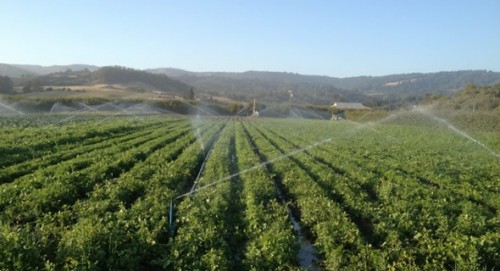The freedom to celebrate and express our unique individuality, our INDEPENDENCE, is closely linked to and made possible by the support and participation of a healthy community of INTERDEPENDENT members. As a farmer treating the land as a “living organism” always reminds me of that dynamic – the food we grow nourishes members in our community and is the result of an incredible diversity of functions performed by innumerable individuals – individuals all connected within Nature’s Web of Life. Happy 4thof July!
Quick Crop Update
Warm weather and long growing days have sped up the maturity of many of our crops. The Blenheim Apricot harvest, which typically starts near the end of July, was almost three weeks early and is over for this year. We picked the last ones on Tuesday, and I am so glad we were able to sneak in a Community U-pick the same day we celebrated this year’s Solstice. (Note: there will be no U-Pick on the Farm this Saturday, July 5th.) The peppers are starting to ripen, also very early. Our Farm Manager, Juan, and I tested some Padrons last week, and the first, small harvest of Yellow Wax peppers happened this week. This means dry-farmed tomatoes are just around the corner. Lots to look forward to!
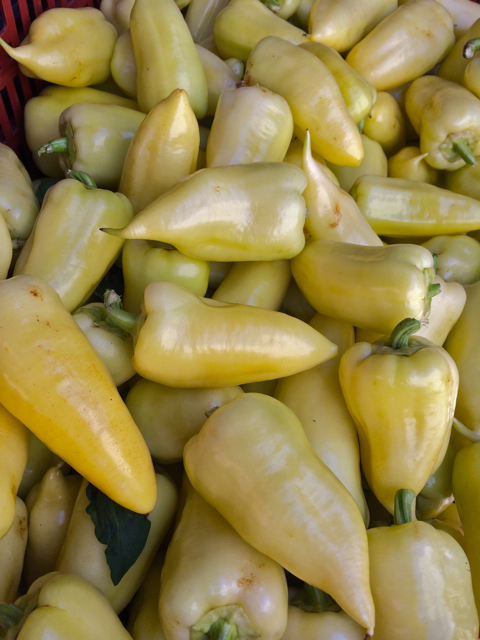
Hungarian Yellow Wax Peppers

Padron Peppers
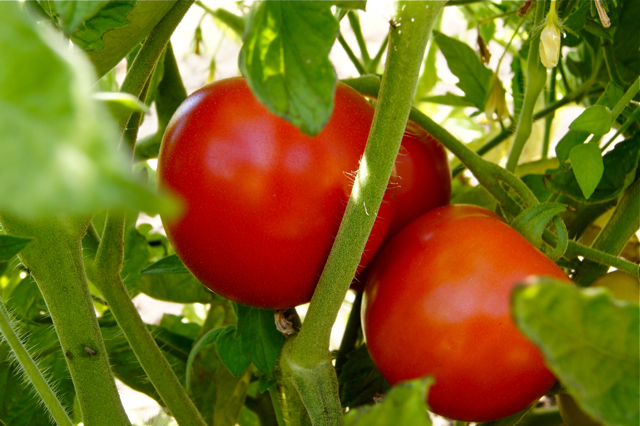
Dry-farmed Early Girl Tomatoes
 Community Supported Agriculture: A healthy partnership of land, plants, animals, and people
Community Supported Agriculture: A healthy partnership of land, plants, animals, and people
It’s “Sign-up time” once again, and it’s wonderful to see how many of our current members have responded so quickly to participate in our 19th CSA season. It is a confirmation and a reassuring feeling to be able to count on the pivotal support of our CSA partnership.
Aldo Leopold in his classic book, A Sand County Almanac, spelled out a “land ethic” which is at the core of our Community Supported Agriculture Program and a guiding principle for land stewardship. The land, Leopold says, “is like a community of interdependent parts, with the soil, the plants, the animals, and the people all playing equally important roles. We share an equal responsibility in contributing to the strength, sustainability and health of the community as a whole.” For the last 18 years the farm’s CSA program and everyone’s participation in it has directly contributed to the health and life of our land, its people, plants, animals, and soil and we are excited and committed to continue on that journey.
We invite you to sign up for our upcoming seasons, starting in December with the 2013-14 Winter Season and continuing with our 2014 Main Season that starts in April 2014. In addition to offering our traditional Small and Regular ShareBoxes, we are also offering, for the first time, a Member “Choice Share”.
What made us introduce this new type of Choice Share, you might ask?
Although we grow a large diversity of different crops throughout the year some crops just don’t match the tastes and cooking habits of everyone. In our family for example, lettuce, arugula, kale, and radishes are a kitchen staple, whereas in others a weekly supply of these is too much. Giving a choice to remove an item in exchange for something that is more desirable, and possibly available in in varying quantities, will increase the value of the share and overall satisfaction for members.
A member who just signed for the Choice Share last week summed it up well: “It’s like having the choice of shopping at the Farmers Market, but still receiving the convenience and reliability of the CSA membership with the Farm.”
Choice Share or Traditional Share, we will of course always strive to give everyone participating in our CSA the best possible experience of eating the freshest, tastiest, and most diverse fruits and vegetable this farm can grow. Thank you for signing up and continuing with us on another nourishing seasonal cycle.
[button link=”http://liveearthfarm.net/new-season-sign-ups/”]New Season Info[/button]
[button link=”http://liveearthfarm.net/choice-share-faq/”]Choice Share – FAQs[/button]
[button link=”http://www.farmigo.com/join/liveearthfarm/2013winter”]Sign-up for 2013 Winter Season[/button]
[button link=”http://www.farmigo.com/join/liveearthfarm/2014main”]Sign-up for 2014 Main Season[/button]
[button link=”http://www.farmigo.com/join/liveearthfarmchoice/box”]Sign-up for a Choice Share[/button]
 New Beginnings without Winter Dormancy
New Beginnings without Winter Dormancy
We are delighted to welcome both returning and new members to celebrate our 20th anniversary of Community Supported Farming. As many returning members have noticed, we have taken the CSA in a new direction by introducing the entire membership to the more flexible and choice based program we offered on a limited basis last year. The decision to change was made because of the overwhelming positive feedback we received from participating members, and because it streamlines the management of the CSA as a whole. We are thrilled, and we hope you are as well, that the shared CSA commitment of eating and cooking with the farm’s seasonal bounty is now a lot more flexible and convenient. (Click here for FAQs about our Shares)
Spring on the farm can be compared to the early phase of pregnancy: we are planting, planning and laying the groundwork for the healthy abundance to come. The freshly tilled soil smells rich and musky, and the first germinating seeds, transplants, and blooming orchards are brimming with the promise of bountiful flavors, smells and colors. I recognize the familiar Spring Season nervousness as I am asked to commit to nature’s irresistible embrace- to dance, once again, the seasonal cycle of fertility and nourishment.
With no rain during March, everything shifted into an accelerated schedule as the soil started drying out quickly. Field preparations, incorporating cover crops, planting, seeding, weeding, cultivating, irrigating all started much earlier. We finished apple pruning mid-March, just in time to get the farm ready for the Sheep-to-Shawl Spring kick-off celebration – which drew a record crowd of almost 400 people.
The farm has also sprung alive with lots of kids exploring the fields, orchards, and wildlife corridors. Besides the on-going programs with homeschool groups, “Food What” teens, and the longstanding Santa Cruz Montessori Wavecrest program, added school tours and overnight stays have kicked into high gear.
Earlier this week it felt like a temporary relief when the storm system a couple of days ago dropped almost 1 inch of much needed rain – a blessing for many of our early plantings of dry-farmed tomatoes, potatoes, summer squash, and green beans. While harvesting carrots in the pouring rain on Tuesday morning, I realized we really never had what one might consider a “normal” winter – one that is cold and wet for long enough to slow us down to rest. Now here we are at the beginning of the Main Season, ready for another journey together through Spring, Summer and Fall. Thank you all for joining us – here’s to another bountiful Season!
 There’s a reason it’s called “Tradition”
There’s a reason it’s called “Tradition”

The traditional Welcome Circle at our Solstice Celebration is always special, because it gives meaning to everything Live Earth Farm stands for: a deep bond with nature, where food is the common link that nurtures our health, our environment and our community. Last Saturday, four long potluck tables were loaded with dishes to be shared. Like in all cultures around the world, this gesture – the sharing of a meal – enriches our sense of community; it celebrates and brings joy and beauty to relationships, as well as a more meaningful connection to the earth under our feet. It was a moment of gratitude for the generosity of the land, it’s people, and the power and grace of what sustains our lives, and the miracle of sunshine, water, soil, seed and air contributing to what becomes our food.
The Summer Solstice celebration was abuzz in activities, with something for everyone to do. Whether it was dipping u-picked strawberries into chocolate ganache donated by “The Buttery”, tractor hayrides with me around the fields, or milking goats and making cheese with Laura, fun was had by all. We were happy to see our neighbor Susan, a local painter and owner of Susun Art Gallery, come by to inspire the kids with art projects, while our son David coordinated an all-hands-on creative bread baking session in the farm’s wood-fired cob-oven. The hay fort was as always a popular hangout for kids, especially this year, thanks to the fun design Dale (the farm’s builder and craftsman) came up with. Unlike last year, the day was pretty warm, so ice cream-making with a hand-cranked ice cream maker was very popular.

It was a fine day to come and just relax, or leisurely explore the farm, visiting the children’s garden, fruit orchards, redwood barn, the pasture-raised chickens, baby goats, or hedgerow plantings. Music accompanied us throughout the day. In the early afternoon, “Mountain Folk”, a local band (two of it’s members are Roger, the Discovery program’s Farm & Garden assistant, and Brian Smith, a longtime CSA member), entertained us with lively folk-music. Later in the day, as has been a tradition for at least 10 years, Kuzanga played their wonderful Zimbabwean marimba rhythms by the fire circle. This year I passed the baton for starting the bonfire to our son David, and some of the children, as is customary, helped him light it. Kuzanga’s music always makes people dance,  and so it accompanied the fire until darkness settled in. For a special treat Linnea Beckett returned to honor us with her graceful fire dance. Linnea apprenticed here 8 years ago, and brought the art of fire dancing with her to the farm. To our surprise, David and longtime member Azalyne were inspired to add to the magic by accompanying her. We let the land weave its magic and revitalize and nourish our bodies and spirits as we embraced the coming of summer. Many thanks to all who participated, and helped to make this another great celebration.
and so it accompanied the fire until darkness settled in. For a special treat Linnea Beckett returned to honor us with her graceful fire dance. Linnea apprenticed here 8 years ago, and brought the art of fire dancing with her to the farm. To our surprise, David and longtime member Azalyne were inspired to add to the magic by accompanying her. We let the land weave its magic and revitalize and nourish our bodies and spirits as we embraced the coming of summer. Many thanks to all who participated, and helped to make this another great celebration.
– Tom
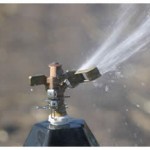 Limited, Precious Water
Limited, Precious Water
 Last week Juan called me, alarmed, because one of our main wells was not pumping water. We had just transplanted leeks and celery early that morning and temperatures were forecast in the mid-eighties. It felt as if someone pushed my Survival Instinct Alert button; at that moment, nothing was more important than to get the water flowing again. A worst case scenario would be that the pump motor or something in the well shaft got damaged; luckily this time the cause was only minor – just a burned-out fuse. It was a stark reminder, however, of how fragile our entire farming system is. We have grown foolishly accustomed to water that is available whenever we want it. The vast agricultural landscapes of California should remind everyone that water is our single most precious commodity. Our ability to manipulate it by pumping, damming, storing and rerouting it has allowed us to convert an otherwise arid landscape into a highly-populated, abundant food-producing region. Water, not oil, is what allows us to farm along these narrow strips of precious fertile soil hugging the Pacific coast. We live on borrowed time as we pump water from our rivers and underground aquifers to grow crops that wouldn’t survive here otherwise. Water conservation is essential if we want to preserve agriculture.
Last week Juan called me, alarmed, because one of our main wells was not pumping water. We had just transplanted leeks and celery early that morning and temperatures were forecast in the mid-eighties. It felt as if someone pushed my Survival Instinct Alert button; at that moment, nothing was more important than to get the water flowing again. A worst case scenario would be that the pump motor or something in the well shaft got damaged; luckily this time the cause was only minor – just a burned-out fuse. It was a stark reminder, however, of how fragile our entire farming system is. We have grown foolishly accustomed to water that is available whenever we want it. The vast agricultural landscapes of California should remind everyone that water is our single most precious commodity. Our ability to manipulate it by pumping, damming, storing and rerouting it has allowed us to convert an otherwise arid landscape into a highly-populated, abundant food-producing region. Water, not oil, is what allows us to farm along these narrow strips of precious fertile soil hugging the Pacific coast. We live on borrowed time as we pump water from our rivers and underground aquifers to grow crops that wouldn’t survive here otherwise. Water conservation is essential if we want to preserve agriculture.
Every season we grow more than 50 different crops, and now that most of our spring plantings are in the ground, watering is a big job. Knowing when and how much water to apply to each crop is both an art and a science. So many variables to consider, such as soil type, specific crop requirements, delivery systems and weather patterns. Water is pumped from wells – some at rates of 200-300 gallons per minute – through an intricate system of tanks, pumps, pipes, hoses, sprinklers and valves, to virtually every plant in each field. We average putting about an inch of water on every crop per week, although requirements vary from crop to crop. For example, spinach may need more but green beans much less. Also, a mature crop will need more water less frequently, whereas a recently planted crop needs less water more frequently. Cool weather crops such as broccoli, cauliflower, lettuce, and most leafy greens, like to be irrigated with above-ground movable aluminum pipe sprinklers, while crops such as strawberries, tomatoes, peppers, squash, cucumbers, and eggplants we drip irrigate. A (very) few crops we don’t irrigate at all, such as our dry-farmed tomatoes and our established Pippin apple orchards.
With the help of a USDA grant, we are evaluating how new technologies for both drip and sprinkler irrigation can help reduce our current water budget. According to our records, last year we used approximately 62 acre-feet of water to raise our crops. Imagine a football field (an acre is only slightly smaller) covered 62 feet high with water. That’s a lot of water! More than 80 percent of our water for the farm comes from groundwater. The rest comes from rainwater collected in ponds.
Since the 1850s, when the first settlers moved into the area and began to farm, agricultural development has expanded from potatoes, grains, apples, and a variety of truck crops to a high value, predominantly berry production system. Today, about half (35,000 acres) of the basin is in irrigated agriculture. Over-pumping concerns were already identified back in the ’50s, and today everybody is in agreement that the basin is over-drafted, causing saltwater intrusion along the coastal areas where land is most intensely farmed.
Over the last few years, the Pajaro Valley (where our farm is located) has become a battleground on the issue of water, creating deep rifts and mistrust among many members of the community. It is increasingly important to educate the public about the decisions that need to be made and actions that must be taken, in order to prevent special interests from calling the shots and squandering this precious resource for short-term monetary gain. If farming is to survive we have to adopt water saving technologies, implement water conserving practices, and promote watershed-based policies that manage water resources equitably for all.
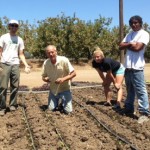 County Supervisor Kaputt working in Live Earth Farm’s Fields
County Supervisor Kaputt working in Live Earth Farm’s Fields
Last week we had an unusual visitor. Santa Cruz County Supervisor Greg Kaputt spent two days working with us in the fields. He arrived on Thursday at 9:00 AM and didn’t hesitate to jump right in to work side-by side with our field crew. First he worked with Noah and Laura picking Cherry Tomatoes, Peppers, and Beets, and then sorted Poblano Peppers with Angeles, Jenny, and Eva.

Santa Cruz County Supervisor Greg Kapput (center) in the field with FoodWhat?!
On Friday he spent the entire day with the “Food What”!? teens. First planting insectary hedgerows along the edges of our fields (a total of almost 1000 feet), and later in the day weeding a patch of Italian Parsley and planting a block of Basil.
Supervisor Kapput has his roots here in Watsonville. He sat on the City Council for several years and is an outspoken supporter of Agriculture and Farming in the Pajaro Valley. He shared his experience as an elected official and the projects and responsibilities he currently is engaged in. A good amount of his time is spent dealing with a myriad of issues ranging from public safety to the county budget, to clearing the Pajaro Riverbed to making sure potholes on roads in his district are fixed.
He said he hadn’t had his hands in the dirt for quite some time, but vividly remembers his summers working in the fields cutting lettuce and how hard that was for him. He was surprised by Live Earth Farm’s diversity of both crops and people working here. He was especially interested in the farm’s Community based business model working side-by-side with the Discovery Program to teach youth, hands-on, the value of healthy food and sustainable farming.
Supervisor Kaputt is known to engage at the grassroots level, and I admire that he took the opportunity during his summer break to spend some time on our farm to experience a slice of what, in my mind, is fundamental to the health of Santa Cruz County – its Agricultural Economy.

FoodWhat?! teen with Corno de Toro peppers
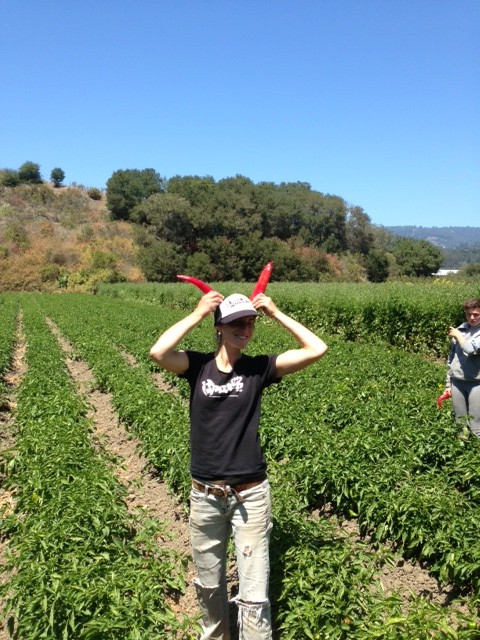
FoodWhat?! teen with Corno de Toro peppers
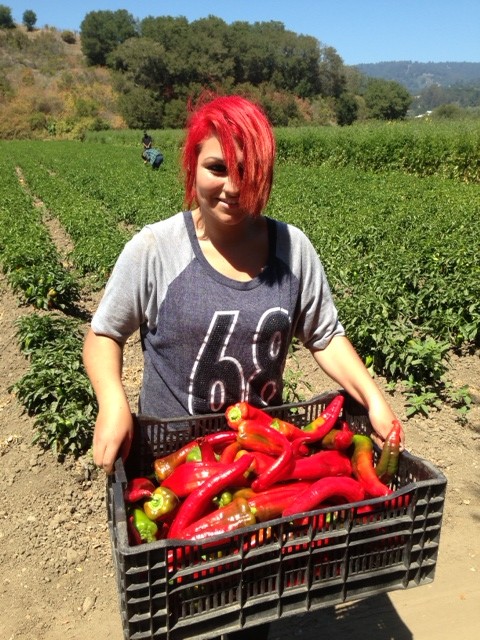
Part of the day’s pepper harvest.
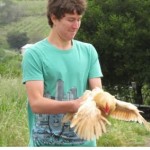 A Bittersweet Moment
A Bittersweet Moment
 Our son David just turned 18 in May, is graduating from Mt. Madonna High school this week, and is off to college by the end of summer. I cant deny feeling a bit emotional about it, seeing David all of a sudden as a mature young adult taking flight, leaving the nest. Watching him on stage for his final performance of the Ramayana — one of the great Indian epics his school has been performing every year since he started preschool 13 years ago (the immortal tale of Shri Rama that teaches us the values of devotion, duty, relationship, dharma and karma) — it struck me how true it is that it takes a village to raise a child. Not just a village, it’s more like an entire city contributed to his upbringing and unfolding maturity over the years.
Our son David just turned 18 in May, is graduating from Mt. Madonna High school this week, and is off to college by the end of summer. I cant deny feeling a bit emotional about it, seeing David all of a sudden as a mature young adult taking flight, leaving the nest. Watching him on stage for his final performance of the Ramayana — one of the great Indian epics his school has been performing every year since he started preschool 13 years ago (the immortal tale of Shri Rama that teaches us the values of devotion, duty, relationship, dharma and karma) — it struck me how true it is that it takes a village to raise a child. Not just a village, it’s more like an entire city contributed to his upbringing and unfolding maturity over the years.
I don’t expect him to take over the farm anytime soon, but I know he draws inspiration from having grown up on a farm. In his college application he wrote, “…organic farming has always been a part of my life. I believe everyone should have access to healthy sustainably grown food like I do. I like to go to a school that prepares me to build food systems that prevent hunger, malnutrition, and obesity.” The farm, his home for nearly 18 years, has nurtured and planted a seed in him, a seed that tells a rich story of a boy growing into a young man, one who now is ready to leave home and test new fields and soil content, to start his own plantings.
 David was barely walking when we started Live Earth Farm, a place in nature surrounded by a diverse community of animals, plants, and people. The farms fields and open spaces became his playground; collecting sticks and stones, digging in the soil, playing with the chickens, goats, dogs and cats, climbing trees to reach that perfectly-ripe sweet fruit, or just hiding in the shade of his favorite climbing tree were simple but enriching activities. I vividly remember how, in spring, he would disappear into cover-cropped fields taller than he was for hours, alone or with his friends, slashing with sticks and make-believe swords at the tall fava beans.
David was barely walking when we started Live Earth Farm, a place in nature surrounded by a diverse community of animals, plants, and people. The farms fields and open spaces became his playground; collecting sticks and stones, digging in the soil, playing with the chickens, goats, dogs and cats, climbing trees to reach that perfectly-ripe sweet fruit, or just hiding in the shade of his favorite climbing tree were simple but enriching activities. I vividly remember how, in spring, he would disappear into cover-cropped fields taller than he was for hours, alone or with his friends, slashing with sticks and make-believe swords at the tall fava beans.
 He has also experienced the physical work involved in farming, doing farm chores, working summers and seeing Dad returning late from the fields often exhausted from seemingly endless work and little time to play. He understands the harsh realities of farming; the risks caused by unpredictable weather, pests, fires, mechanical equipment breakdowns… all of which cause damage and loss on the farm. He understands the seasonality of food, the cycles of planting, growing, harvesting, celebrating and resting. Every day, when we prepare and share meals, he gets to experience how crops only recently growing in our fields are transformed into a nourishing meal. In our family, sharing meals is an important daily ritual, a time to slow down and simply enjoy and be grateful for being together.
He has also experienced the physical work involved in farming, doing farm chores, working summers and seeing Dad returning late from the fields often exhausted from seemingly endless work and little time to play. He understands the harsh realities of farming; the risks caused by unpredictable weather, pests, fires, mechanical equipment breakdowns… all of which cause damage and loss on the farm. He understands the seasonality of food, the cycles of planting, growing, harvesting, celebrating and resting. Every day, when we prepare and share meals, he gets to experience how crops only recently growing in our fields are transformed into a nourishing meal. In our family, sharing meals is an important daily ritual, a time to slow down and simply enjoy and be grateful for being together.
 The farm is intuitively a part of him, his body has been nurtured by food that came from the land, and has lived many seasons through his four senses. Soon he’ll be off to explore and discover his passion, his inner compass seeking out direction in the challenging opportunities of our time, inviting him to raise his voice, to engage in and construct communities for a world that is more just, more healthy, and more democratic… and (I am sure) in which sustainable agriculture and farming families form a fundamental part of a better future. The seeds planted in him carry farming values of respect, courage, perseverance, mutual assistance, and love, lots of love. Love for friends, family, and community, love for nature, love of agriculture, and most importantly – love of life. David is ready to graduate, to leave his school and home to explore the world. It is a blessing for Constance and I to feel that by letting go we are invited to witness and walk with him on his next journey.
The farm is intuitively a part of him, his body has been nurtured by food that came from the land, and has lived many seasons through his four senses. Soon he’ll be off to explore and discover his passion, his inner compass seeking out direction in the challenging opportunities of our time, inviting him to raise his voice, to engage in and construct communities for a world that is more just, more healthy, and more democratic… and (I am sure) in which sustainable agriculture and farming families form a fundamental part of a better future. The seeds planted in him carry farming values of respect, courage, perseverance, mutual assistance, and love, lots of love. Love for friends, family, and community, love for nature, love of agriculture, and most importantly – love of life. David is ready to graduate, to leave his school and home to explore the world. It is a blessing for Constance and I to feel that by letting go we are invited to witness and walk with him on his next journey.
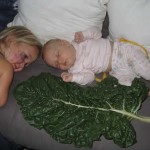 One for the Record Books
One for the Record Books
We always love getting pictures of your children and Live Earth Farm’s produce to share with everyone in the newsletter. Here’s the latest — from our very own Jessica Ridgeway, director of LEFDP. Her new baby, Current, shares the stage with a truly massive chard leaf, and her older sister, Ophelia.
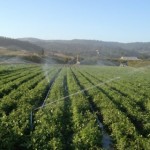 Living on the Water’s “Edge”
Living on the Water’s “Edge”
Last week while accompanying our son to the east coast to start his journey as a college student, we saw large tracks of corn and soybeans severely stunted from this year’s record-breaking drought. I am so used to irrigation agriculture that I had to remind myself that the vast majority of this country’s farmland is rain-fed, and therefor at the beck and call of nature’s caprices. Climate change will inevitably expose us to more such frequent climatic extremes and oblige us to rethink our current system of mono-cropping. The challenge will be to develop food systems that are more resilient by focusing on diversification, less fossil fuel dependency, optimum nutrition, and most importantly, create accessibility to food through diverse decentralized regional and local distribution networks. The idea of building local and regional foodsheds may still be in its infancy, however it is an exciting one; such a shift would result in consumers becoming more aware of where their food comes from, leading to more active involvement in building a more sustainable food supply in the long term.
Driving along the highway in Illinois and Indiana, looking at mile after mile of desiccated crops, I am relieved that our farm’s harvest does not directly rely on water falling from the sky. Most farms in the arid west, especially here in California, depend on stored water – either from man-made reservoirs or vast underground aquifers. Here in the Pajaro Valley, farms like ours all depend on groundwater, which has to be pumped from wells, some as deep as 500 feet or more. A failing water pump, on a hot day, will immediately bring us face to face with the essential importance of this life-giving resource. Knowing when and how much water to apply to a particular crop is both an art and a science. There are many variables to consider, such as soil type, specific crop requirements, delivery systems and weather patterns. To conserve as much water as we can we use drip irrigation, mulching, and dry farming. An intricate system of tanks, pumps, pipes, hoses, sprinklers and valves transport this limited and increasingly costly resource to our crops. On average, we have to put about an inch of water on our crops every week. Water requirements vary from crop to crop, for example spinach may need more but green beans much less. Also, a mature crop will need more water less frequently whereas a recently planted crop needs less water more frequently.
At the current rate, more groundwater is being extracted from our aquifer than is being replenished; in some cases along the coast, this overdrafting of groundwater is causing saltwater intrusion. We are living on borrowed time as we pump unsustainable amounts of water. It may seem surprising to some, but over 80% of water used in California is used in Agriculture. Conserving water is everyone’s responsibility, especially we farmers who are using the bulk of it. We will need to come up with ways to conserve more or even grow less or different crops to lower our current consumption.
– Tom
 Technology to the Rescue
Technology to the Rescue
Overwhelmed with the amount of harvesting going on at the moment it’s been tricky to stay on top of propagation and planting schedules. Most of our crops are raised from seed, grown into seedlings and hand transplanted when they are large enough to thrive under the more challenging field conditions. The moment a seed is sown the clock starts ticking. Field preparations need to be timed so as to overlap with the maturity of the seedlings which then need to be planted on a specific schedule. Lately we have been falling behind on our fall and winter plantings and needed serious help. Luckily, I held on to a seedling transplanter I bought a few years ago and was about to sell it since it was ill suited for our small diversified farming operation. The entire implement was too heavy for even our largest tractor and too long to make the tight turns at the end of our fields. This particular transplanter was best adapted for perfectly level fields where rows are long and soils are light. But as it often happens, necessity triggers the most creative solutions and we changed the set up so as to only plant single rows instead of double rows, which ended up cutting the length and weight of the implement in half. We suddenly were able to plant what would normally take 16 people to plant in two days only 5 people in half the time. It was a welcome relief, not only on our bodies but it also saved us from falling behind on our planting successions and harvests later in the season. I am glad that I am by nature one who resists throwing away or selling anything here on the farm that may still have a potential future use, even if that use may not yet be identified. It sure paid off this time.
– Tom


